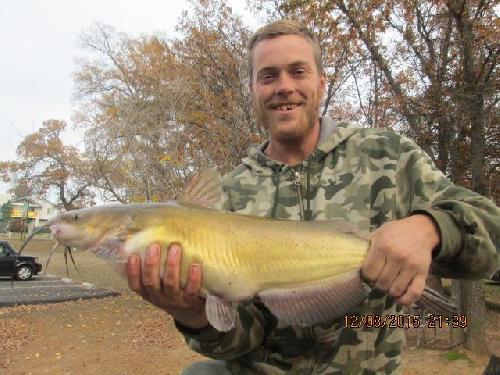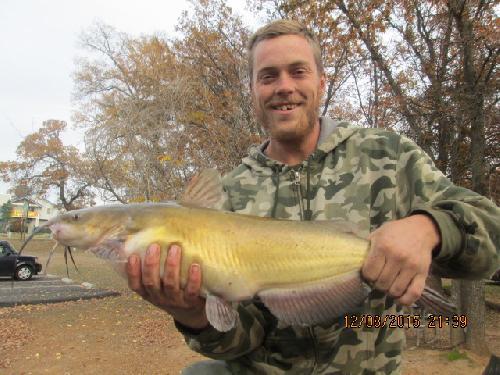Long Range Fish Report
From Sportfishing
From Sportfishing
Fish Report for 12-28-2015

Glory Hole Fishing Report
12-28-2015
Glory Hole Sports Staff
Water Conditions: New Melones Lake is currently holding 305,568 acre-feet of water. The lake level came up eight feet this past week. It is currently at 810 ft. above sea level and 276 ft. from full. The water clarity is stained due to recent rainfall and wind. Some areas are clear and not affected by the storms. The water temperature remains cool, with the average being 50-54 degrees. The dam area is buoyed off due to current that is created when releasing water. Glory Hole Point boat launch is a one lane dirt and gravel road leading off of the end of the point. There is not a courtesy dock and it is best to launch with a 4-wheel drive vehicle.
Trout: Slow. The DFG has recently planted fish in New Melones. We still haven't seen many trout being caught at the lake yet. A few planted fish have been caught, but we are waiting for a wave of holdover trout to move to the shallow water and up toward the surface. It should be any day now that the trout are shallow and being caught from the shoreline. Bank anglers should try floating a ball of Power Bait off of the bottom. Rainbow and chartreuse are both very productive colors on New Melones. Also, the garlic scented baits seem to attract a few more fish and will get more bites. Use a standard bait rig with a sliding egg sinker and a swivel. It is very important to use a light wire hook to ensure your bait is floating off of the bottom. Boating anglers should try fishing near main lake pockets and creek channels. The trout will be drawn to areas that have had some fresh water flowing into the lake. Try using a casting spoon to find actively feeding fish. Make multiple casts and cover plenty of water. For anglers who prefer to troll, try top-lining a trolling spoon or a small minnow-like crankbait. The fish should be moving shallow, so it is a good idea to troll near the shoreline. It is best to use fewer rods and switch baits often. This way if you do get hung up you will be able to back track and retrieve you lure. Trout will feed on shad patterned baits, but sometimes bright colors will catch their attention best. Switching from natural presentations, to bright presentations throughout the day will help you determine what the fish are attracted to. We do encourage catch and release for the brown trout as The Department of Fish and Game will no longer be planting them. Carefully measure, weigh and photograph trophy fish and send us pictures and information.
Kokanee: Done. Generally we will start seeing a few fish caught in April.
Bass: Good. The water temperature has dropped to an average winter temperature. The fish will be less active during these cold months, but you can still catch a bunch of fish and some big ones. The main thing is to adjust accordingly. When the fish are slowed down, a lure that is moving slow will attract bites. The fish don't want to exert too much energy chasing down their prey and are looking for easy meals. Try dragging soft plastics baits along the bottom. Use bulky baits that don't have a bunch of moving parts. Senkos, tubes and beavers are all good choices. A 3/4oz. football head jig is a must have for the colder months. The heavier jig will stay on the bottom and you will have a good feel even in deep water. Plus, the head of the bait creates a grinding and ticking sound each time it comes in contact will hard rock. Dark colors work well when the water is cold. Try using green pumpkin, brown and purple colored jigs. It is also a good idea to add scented to help the fish locate the bait and to hold on longer once they bite. A vertical presentation can be deadly when the fish are schooled up. A jigging spoon is a good choice to catch fish that are directly under the boat. If that doesn't work, switch to a drop-shot rig. Lower the bait to where the fish are a just hold the bait there. They will become agitated by the presence of your bait and swim over to eat it. PLEASE PRACTICE CATCH AND RELEASE. The bigger fish are the future of our lake. Take photos and carefully release the fish back into to the lake to maintain a healthy fish population for generations to come.
Catfish: Slow. Some anglers will target catfish all year long. When fishing for catfish in cold water you can expect to get very few bites. Some huge catfish do get caught during the winter, often by anglers targeting trout. Power Bait dough, nightcrawlers and marshmallow will work for both trout and catfish. Try fishing near the main river channel and deep water. Use plenty of scent to draw fish to your bait.
Crappie: Slow. Very few anglers target crappie at this time of the year. They will school up and feed on shad along with the bass and trout. Try using live minnows or vertical jigging spoons if you can locate a school of crappie. They will generally be found holding tight to large, isolated standing timber.
Trout: Slow. The DFG has recently planted fish in New Melones. We still haven't seen many trout being caught at the lake yet. A few planted fish have been caught, but we are waiting for a wave of holdover trout to move to the shallow water and up toward the surface. It should be any day now that the trout are shallow and being caught from the shoreline. Bank anglers should try floating a ball of Power Bait off of the bottom. Rainbow and chartreuse are both very productive colors on New Melones. Also, the garlic scented baits seem to attract a few more fish and will get more bites. Use a standard bait rig with a sliding egg sinker and a swivel. It is very important to use a light wire hook to ensure your bait is floating off of the bottom. Boating anglers should try fishing near main lake pockets and creek channels. The trout will be drawn to areas that have had some fresh water flowing into the lake. Try using a casting spoon to find actively feeding fish. Make multiple casts and cover plenty of water. For anglers who prefer to troll, try top-lining a trolling spoon or a small minnow-like crankbait. The fish should be moving shallow, so it is a good idea to troll near the shoreline. It is best to use fewer rods and switch baits often. This way if you do get hung up you will be able to back track and retrieve you lure. Trout will feed on shad patterned baits, but sometimes bright colors will catch their attention best. Switching from natural presentations, to bright presentations throughout the day will help you determine what the fish are attracted to. We do encourage catch and release for the brown trout as The Department of Fish and Game will no longer be planting them. Carefully measure, weigh and photograph trophy fish and send us pictures and information.
Kokanee: Done. Generally we will start seeing a few fish caught in April.
Bass: Good. The water temperature has dropped to an average winter temperature. The fish will be less active during these cold months, but you can still catch a bunch of fish and some big ones. The main thing is to adjust accordingly. When the fish are slowed down, a lure that is moving slow will attract bites. The fish don't want to exert too much energy chasing down their prey and are looking for easy meals. Try dragging soft plastics baits along the bottom. Use bulky baits that don't have a bunch of moving parts. Senkos, tubes and beavers are all good choices. A 3/4oz. football head jig is a must have for the colder months. The heavier jig will stay on the bottom and you will have a good feel even in deep water. Plus, the head of the bait creates a grinding and ticking sound each time it comes in contact will hard rock. Dark colors work well when the water is cold. Try using green pumpkin, brown and purple colored jigs. It is also a good idea to add scented to help the fish locate the bait and to hold on longer once they bite. A vertical presentation can be deadly when the fish are schooled up. A jigging spoon is a good choice to catch fish that are directly under the boat. If that doesn't work, switch to a drop-shot rig. Lower the bait to where the fish are a just hold the bait there. They will become agitated by the presence of your bait and swim over to eat it. PLEASE PRACTICE CATCH AND RELEASE. The bigger fish are the future of our lake. Take photos and carefully release the fish back into to the lake to maintain a healthy fish population for generations to come.
Catfish: Slow. Some anglers will target catfish all year long. When fishing for catfish in cold water you can expect to get very few bites. Some huge catfish do get caught during the winter, often by anglers targeting trout. Power Bait dough, nightcrawlers and marshmallow will work for both trout and catfish. Try fishing near the main river channel and deep water. Use plenty of scent to draw fish to your bait.
Crappie: Slow. Very few anglers target crappie at this time of the year. They will school up and feed on shad along with the bass and trout. Try using live minnows or vertical jigging spoons if you can locate a school of crappie. They will generally be found holding tight to large, isolated standing timber.
< Previous Report Next Report >
More Reports
Glory Hole Fishing Report
New Melones ReservoirWater Conditions: New Melones Lake is currently holding 277,743 acre-feet of water. The lake level came up two feet this past week. It is currently at 802 ft. above sea level and 284 ft. from full. The water clarity is clear in most of the lake and stained in some of the creek arms. The water temperature continues to cool, with the average being 50-54 degrees. The dam area remains buoyed off due to current that...... Read More
Glory Hole Fishing Report
New Melones Reservoir
12-14-2015
Water Conditions: New Melones Lake is currently holding 272,870 acre-feet of water. The lake level came up one foot...... Read More

LongRangeSportfishing.net © 2025. All Rights Reserved.
Website Hosting and Design provided by TECK.net
Website Hosting and Design provided by TECK.net